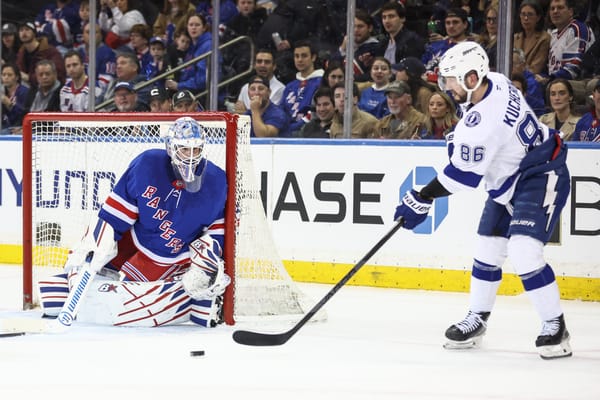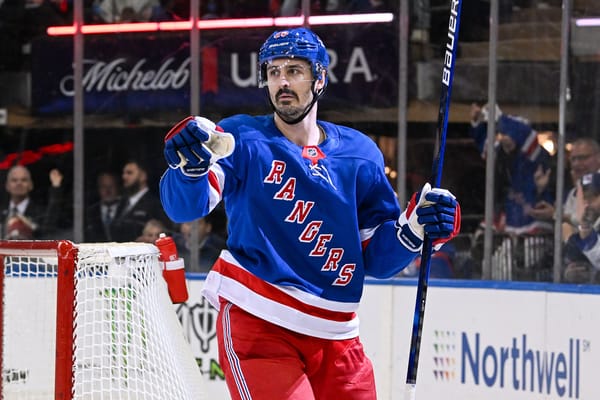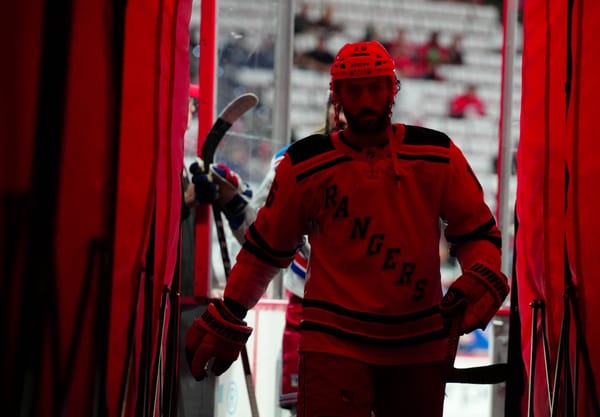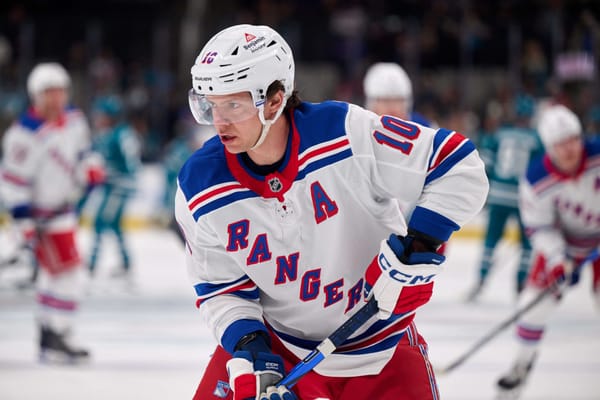The Time Has Come for the Rangers to Prepare to Make Decisions in Net
The Rangers have to act now in order to best prepare for tough decisions to come over the summer.
Rangers’ 2016 sixth-round pick Tyler Wall is having an absolutely dominant senior season with UMass-Lowell. The 21-year-old goaltender boasts a 6-1-2 record with an absurd .947 save percentage. He’s already won the Hockey East Defensive Player of the Week award three times early into the college hockey season and is probably the early favorite to win the NCAA’s Mike Richter Award for outstanding goaltending.
Though he struggled heavily during his sophomore season, Wall has been, uhh, a wall during most of his tenure at UMass-Lowell. This is a bona fide goaltending prospect who will undoubtedly have a future in professional hockey. As a senior that was drafted four seasons ago, the Rangers have until August 15th, 2020 before they lose his rights.
Barring a meltdown, the team will certainly want to get him under contract. Since he’ll be 22 years old at the start of next season, it probably would not serve him well to spend more than a short spell in the ECHL. Not to mention Wall could take the Hayes/Vesey route and wait to become a free agent if he doesn’t see a viable path up the depth chart in New York. This is a goaltender that the team will likely want as the backup in Hartford for the 2020-2021 season.
The current backup in Hartford is Adam Huska, who was Wall’s Hockey East comrade during the 2017-18 and 2018-19 seasons when Huska suited up for UConn. Though he struggled as a junior last season, Huska was one of the few bright spots on some terrible Husky teams.
Huska has come out of the gate flying in his first full AHL season, posting a .925 save percentage in five games for the Wolf Pack. This is, of course, a small sample. Still, he has an extensive resume as a quality goaltending prospect. Huska was outright dominant in the USHL. His college experience, as previously noted, was an overall success. And, he was a stalwart for Slovakia at the U18 and U20 World Championships. There are no guarantees he carries this kind of form, but there is plenty of reason to believe he can. If so, then it will be time to get him more games in a starting — or at least hybrid — role for Hartford.
Huska would be taking that starting role from Igor Shesterkin, who hasn’t missed a beat since making the trek to North America from the KHL. The Russian netminder was named the AHL Goaltender of the Month for October, posting a .932 save percentage and earning one shutout in seven games. Though Hartford is a good AHL team, Shesterkin has anchored the defense and has turned in some really strong performances.
Even though it’s early in the season, with the way he is playing the Rangers can only realistically expect Shesterkin to remain happy and motivated in the AHL for so much longer. Especially when he could be earning 10 times as much money back home. The “needs to adapt” excuse is going to lose any real meaning very soon. At some point, it’s going to be impossible to deny that Shesterkin has barely flinched in his transition to North American ice and that he is ready for the NHL.
The Rangers have remarkable skill and depth on their goaltending depth chart, and that’s without mentioning 2018 second-round pick Olof Lindbom, who is playing relatively well in Sweden. It’s not the first time this has been the case, as Blueshirts’ brass has done a remarkable job of planning ahead with the foresight that Henrik Lundqvist would eventually have to pass the torch to someone younger. In fact, they have done such a good job that they are quickly approaching a situation where they have more capable goaltenders than they can fit in the organization. The Rangers have a Trickle Up effect where everyone is deserving of a promotion, and for the first time since Mike Richter’s career ended the team has some decisions to make in net.
Imagine how different the Washington Capitals’ history would have played out had they chosen Semyon Varlamov or Michal Neuvirth instead of Braden Holtby. How much worse would the Anaheim Ducks be with Freddie Andersen rather than John Gibson? Look at how much worse off the Ottawa Senators are for having hitched their wagon to Andrew Hammond rather than Robin Lehner. That is the dilemma currently facing the Rangers. There’s little doubt that a Lundqvist successor currently sits in the organization. Now, it’s about ensuring they hand over the throne to the right guy.
Though the Rangers do not have to officially make any decisions just yet, they absolutely must put themselves in the best position possible to make a confident, informed choice. It’s going to be incredibly tricky to do so.
The path of least resistance is trading Alexandar Georgiev, and that has been the path the consensus believes the Rangers will, or should, follow. There are plenty of teams who will be looking for a young, competent goaltender, and Georgiev is just that.
However, the Rangers themselves are technically one of those teams, and is he a player they really want to be parting ways with? Over the last two seasons, Georgiev has prevented 11 more goals than expected based on shot quantity and quality (Evolving Hockey). In fact, since 18-19, he ranks seventh among all NHL goaltenders by save percentage above expected. This is particularly remarkable given that Georgiev was thrown into a bad situation where he has been forced to keep a bad team in games every night despite a barrage of shots. As elite as Shesterkin has been in the KHL and AHL, he still hasn’t seen a single second of NHL action. It would be a bold move to give up a 23-year-old goaltender like Georgiev who is so far proving capable in the NHL.
Of course, with just 50 NHL games to his name, it’s not enough to definitively forecast Georgiev as a top-10 NHL goaltender of the future. At a minimum, the Rangers need to give him more starts to see what they truly have. He appears to be slated for 32 starts this season, which is not nearly enough given what is at stake. The Rangers need to see a bigger sample, and they need to see how he can perform in a starter’s role, where he’s playing three out of every four games.
For that matter, it would go a long way to see Shesterkin in even just a handful of NHL games. Just as it would be risky to move on from Georgiev in favor of a goaltender who hasn’t stepped on NHL (regular season) ice, it would also be dangerous to trade away a young goaltender who has put up video game numbers at every level he has played. It would be both reckless and anti-climactic to move on from either one of these players before the team can even figure out what they have in both.
Frankly, the only way the Rangers can buy themselves the necessary time to sufficiently evaluate the two goaltenders would be at Henrik Lundqvist’s expense. Looking at the situation where absolutely nothing is considered except the long-term health of the organization, and the answer should appear easy. Lundqvist will be halfway to 39 years old when the 2020-2021 season begins, when he will be in the final year of his contract. It’s difficult to imagine him hanging around long enough to play a part in the next Stanley Cup window. Objectively speaking, the best long-term move would be to trade Lundqvist, go with a Georgiev/Shesterkin tandem, and let those two battle it out.
That scenario of course has numerous obstacles, both practical and emotional. Many players have left the Rangers in recent years on depressing terms, but Lundqvist is a whole different animal. Cutting ties with Lundqvist before his contract runs out would mean a franchise legend departs. He’s not making such a move any easier with his play so far this season. Statistically, he’s been a top-five goaltender in the NHL this year.
The Devils held onto Brodeur well past his expiration date despite an in-prime Corey Schneider proving more than ready to take the job. How can the Rangers make such a callous decision with one of the greatest players in team — and NHL — history when he’s still a top goaltender? Would he feel slighted? Would it be a marketing disaster? Would it affect the locker room? Even if the team can work through that noise, it likely would not be easy to find a team in need of a goaltender who could take on Lundqvist’s $8.5M cap hit and to whom the Swede would accept a trade.
The Rangers have more capable goaltenders than they can realistically keep happy for much longer. That, of course, is a good problem to have. But good problems are still problems.
At best, the current situation will become untenable by the summer. Shesterkin will in all likelihood be well past his due date for the start of his NHL career, and there simply won’t be room for him, Georgiev, and Lundqvist. It’s not the first time we’ve written about this inevitable situation, but Winter is Coming no longer; it has arrived. There are three goaltenders who will be under contract and requiring NHL minutes next season and spots for only two of them. The Rangers have to start immediately thinking about how to put Georgiev and Shesterkin in the best positions not only to develop, but to provide Rangers’ management with the information necessary to make the right decisions that will be unavoidable over the summer.




